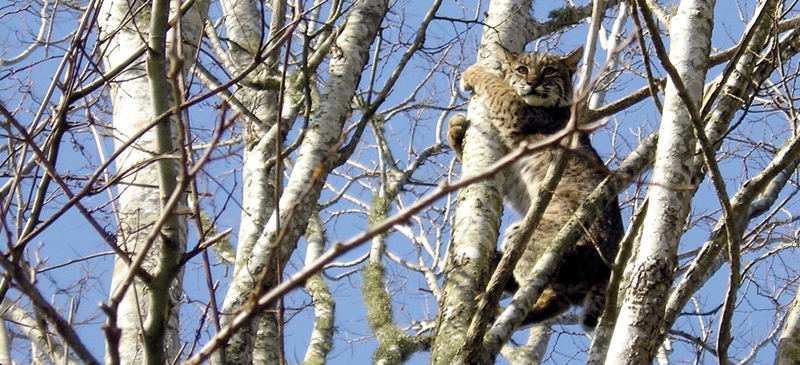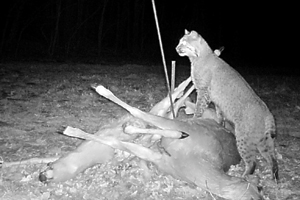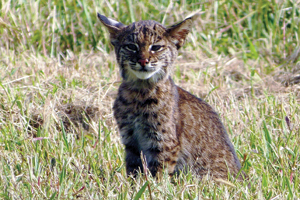The Secretive Wild Feline: A profile of bobcats in Maryland

Bobcat in a tree; by Don Brevelle, USFWS
Among the many wild animals that roam our farms, fields and forests, there is one native midsize carnivore that goes largely unnoticed: the bobcat. In fact, the bobcat is the only wild member of the cat family found in Maryland.
Pet or predator?
Bobcats resemble domestic house cats with a few key differences. They are considerably bigger—about twice as large as typical pet cats, ranging in size from approximately 15-40 pounds and 29-39 inches in length.
They have a stocky build and notable pointy tufts of black fur at the tips of the ears. They also have that characteristic ‘bobbed’ tail for which they’re named. Their short tails have a distinct dark band near the tip and their coats range from grayish brown to yellowish brown in color. They have a mix of dark stripes and spots on their coats that are also highly variable —from barely noticeable to distinct. Their stomachs are typically white and contain dark spots, with each animal having its own unique spot patterns. Bobcats also have a ‘ruff’ of longer fur around their faces that helps give these animals a distinct look.
Range
Bobcats can be found in suitable habitat throughout most of North America from central Mexico northward to include many parts of Canada, therefore encompassing most of the continental United States. In Maryland, bobcats are found in greater numbers in the western region (Garrett, Allegany, Washington and Frederick counties) but can occasionally be found as far east as the western shore of the Chesapeake Bay.
While bobcats can be found occupying many different habitat types, they seem to favor areas with dense vegetative cover with interspersed openings. Their affinity for these rugged types of habitat that people tend to shy away from may contribute to the fact that people do not commonly see them.
Occasionally, however, people do hear them vocalize, which eerily sounds like a baby screaming.

Trail cam footage at Dan’s Mountain
Some examples of areas bobcats find attractive would include swamps and bogs; clear-cuts and other forested areas with a lot of thick, brushy cover; small farm fields; power lines; rocky slopes; and other ‘disturbed’ sites that promote early successional vegetative growth. Rock ledges and outcrops are prime spots to find bobcat signs, as they hunt along these areas and also like to den in rock outcrops. When traveling, they like to move along trails and dirt roads that aren’t frequented by people.
On the prowl
Bobcats are efficient carnivores and mostly nocturnal, or active at night. They feed primarily on small mammals such as mice and voles, rabbits, squirrels and woodchucks. However, as opportunistic predators, they sometimes feed on carrion (decaying meat) and may on occasion even take larger animals like deer.
Interestingly, they do not rely on their noses like wild canines do. They instead rely mostly on their excellent senses of hearing and sight to locate and capture their prey. Bobcats are very stealthy hunters that move through the forest silently and can remain motionless for long periods of time while stalking their prey. One interesting behavior is that they will cache their food, covering it with dirt, leaves, sticks or even snow to hide it from other scavengers so they may return for another meal at a later time.
Lifecycle
Bobcats tend to be solitary animals most of the year, pairing up for the breeding season, which occurs late winter through spring (January-April). Once bred, the female will have a litter of young kittens after about a two-month gestation period. Litters have been documented ranging in size from 1-7, but most contain 2-3 kittens.
While caring for its young, a female may have several dens throughout its territory. Bobcats do not construct dens but use existing shelters instead. They utilize holes or crevices in brush piles, downed logs, hollow logs, rock outcrops or trees, and have even been known to take advantage of abandoned human structures such as old cabins or sheds.

Bobcat kitten; by Allie Steward, USFWS
Kittens remain with the female until early fall when they disperse, or move out and seek a territory of their own. They usually begin to breed at 1-2 years of age to carry on the cycle.
Sightings and status
Bobcats are a unique part of our diverse ecological landscape. The Maryland Department of Natural Resources receives few complaints about the species, mostly due to their secretive nature. Despite being highly efficient predators, they don’t seem to target domestic animals or pets, aligning with their preference to avoid humans.
Like several other forest-dwelling species, bobcats have benefited from the maturation of Maryland’s forest landscape since the mid-1900s. From the time European settlers arrived here, people have cleared the landscape creating tillable land and making use of the forest resources for the charcoal and ship building industries, and a variety of other uses. The resulting cleared landscape did not leave favorable habitats for many native fauna, including bobcats. Mother Nature is resilient, though, and as the forest matured and rebounded, many species have also recovered.
I, for one, am happy knowing that we have these natural predators sharing our forests. If you spend time enjoying all that Maryland’s natural world has to offer, you may be lucky enough someday to catch a glimpse of our only wild member of the feline family.
Article by Harry Spiker—Wildlife and Heritage Service game mammal section leader. Appears in Vol. 21, No. 2 of the Maryland Natural Resource magazine, spring 2018.


 1-888-373-7888
1-888-373-7888 233733
233733